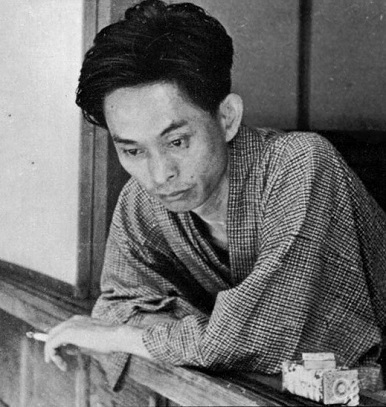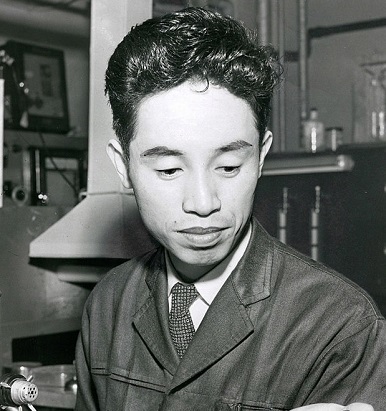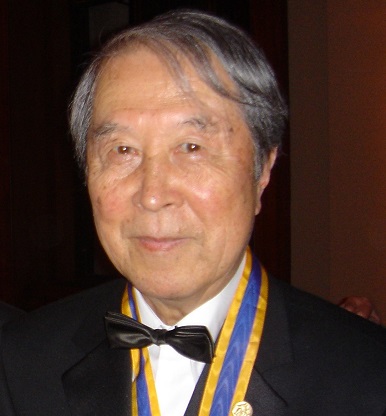Yasunari Kawabata (1899-1972)

Graduated from the Faculty of Letters in 1924
The 1968 Nobel Prize in Literature
Prize given "for his narrative mastery, which with great sensibility expresses the essence of the Japanese mind"
Yasunari Kawabata was the first Japanese person to have won the Nobel Prize in Literature. He became aware of the Nobel Prize at the early age of 17 and was active in a private literary magazine when studying at UTokyo. The third quote (3) is an excerpt from his Nobel Lecture titled "Japan, the Beautiful and Myself," in which he expounded upon the aesthetic values of the Japanese. The second quote (2) is a farewell made at the funeral of Riichi Yokomitsu, Kawabata's friend and fellow member of the Shinkankaku-ha (New Sensation School) and a co-founder of the magazine Bungei Jidai (The Artistic Age). Although Kawabata said in his novel (see the first quote, 1) and lectures that suicide is not committed by people who have reached enlightenment, he himself chose to end his own life in 1972, upsetting many people.
Leo Esaki (1925-)

Graduated from the Faculty of Science in 1947
The 1973 Nobel Prize in Physics
Prize given "for [his] experimental discover[y] regarding tunneling phenomena in semiconductors"
After graduating from the University of Tokyo, Dr. Esaki worked at Tokyo Tsushin Kogyo Corporation (the predecessor of Sony) and devoted himself to the research and development of transistors. In 1957, he discovered that electrons, if energized with high voltage, will pass through a thin wall. This phenomenon proved the presence of electron tunneling, which quantum mechanics had theoretically predicted. In recognition of this achievement, an innovative type of semiconductor that uses electron tunneling was created and called the Esaki diode. The Esaki diode greatly contributed to research in metals and superconductors, as well as to the development of various industries around the world. The second quote (2), which suggests that university entrance examinations focused on rote learning may impede students' creativity, gives insight into Dr. Esaki's character as an excellent educator. In the first quote (1), Dr. Esaki shows his pride in the fact that science is built on logic, making it the most reliable discipline. The third quote (3) means that a diversity of viewpoints acts as a driving force for creativity. This quote holds particular significance to the University of Tokyo, which values education in the liberal arts.
Eisaku Sato (1901-1975)

Graduated from the Faculty of Law in 1924
The 1974 Nobel Peace Prize
Prize given "for his proposal of the Three Non-Nuclear Principles"
The only Japanese person who has received the Nobel Peace Prize is Mr. Eisaku Sato, a politician who is said to have narrowly managed to pass the entrance examinations of the University of Tokyo with the help of notebooks borrowed from his older brother. The second quote (2) comes from a speech he made when he visited Okinawa for the first time as prime minister in 1965. It was not until 1972 that Okinawa was finally returned to Japan. The third quote (3) represents his ideas of the Three Non-Nuclear Principles, which were the reason he was awarded the Nobel Peace Prize. The first quote (1) is a comment he made at a press conference when all the members of his cabinet resigned in 1972. This press conference was unusual because he drove newspaper reporters out of the conference, saying that they made up stories differing from his true intentions. He instead gave preference to television reporters because he said that television would convey his comments exactly as he said them.
Kenzaburo Oe (1935-)

Graduated from the Faculty of Letters in 1959
The 1994 Nobel Prize in Literature
Prize given "for creating with poetic force an imagined world, where life and myth condense to form a disconcerting picture of the human predicament today"
The second Japanese person to win the Nobel Prize in Literature was Kenzaburo Oe. He made his debut as a writer during his days at the University of Tokyo when he contributed his short story titled The Strange Work (Kimyo na Shigoto) to The University of Tokyo Newspaper. From the first quote (1), an excerpt from one of his nonfiction works intended for a young audience, we can see the stance that underlies Oe's literature. The second quote (2) is a comment he made during an interview for a special feature of Tansei 17 (English edition Volume 6) published in 2006. He also said in the interview that "What I learned at Todai was how to read a foreign language." The third quote (3) is from his Nobel Lecture titled "Japan, The Ambiguous, and Myself," which was inspired by Mr. Kawabata's Nobel Lecture, "Japan, the Beautiful, and Myself."
Masatoshi Koshiba (1926-)

Graduated from the Faculty of Science in 1951
The 2002 Nobel Prize in Physics
Prize given "for pioneering contributions to astrophysics, in particular for the detection of cosmic neutrinos"
As the father of neutrino astrophysics and as a teacher who is strict at times, Professor Koshiba has had great influence on his successors, including Professor Takaaki Kajita. The words that are key to deciphering Professor Koshiba's achievements are "intuition," as in the third quote (3), and "research egg," as in the second quote (2). Being the leader of a massive research project, he had to decide on what, when, where, with whom and with what kind of devices his team should experiment. He proudly asserts that he is able to constantly make optimal judgements because he "squeezes his brain" by ruminating over these matters, thus strengthening his intuition. Also, he has been able to carry out unique research because he has always incubated a variety of idea "eggs," believing that those eggs will hatch someday, even if they are not ready now. Professor Koshiba famously persuaded (see the first quote, 1) the CEO of Hamamatsu Photonics to manufacture 50 cm-diameter photomultiplier tubes, which had been considered to be difficult to make, by stressing his seniority over the CEO (although Professor Koshiba is only one day older). This anecdote shows us that to achieve something great, you need to have a strong will that may appear to be sometimes irrational.
Yoichiro Nambu (1921-2015)

Graduated from the Faculty of Science in 1942
The 2008 Nobel Prize in Physics
Prize given "for the discovery of the mechanism of spontaneous broken symmetry in subatomic physics"
Professor Nambu has won great respect from researchers around the world as a "prophet of physics." He was a trailblazer in not only spontaneous symmetry breaking, but almost all the tenets of today's particle physics theory, including string theory and quantum chromodynamics. Recognized by everyone as an unparalleled genius, his greatness can be understood through the following anecdote. Professor Toshihide Maskawa, who shared the 2008 Nobel Prize in Physics with Professor Nambu, said in tears at the press conference that winning the Nobel Prize together with Professor Nambu brought him incomparable joy. The third quote (3) is the closing comment Professor Nambu made during a speech held at the University of Chicago to commemorate his winning of the Nobel Prize. This comment precisely and passionately expresses his appreciation for the complexities of nature based on modern physics. The first (1) and second (2) quotes are excerpts from an interview Professor Nambu gave to a newspaper in Fukui Prefecture, where he lived until graduating from high school. Through these quotes, we can see his profound confidence in physics and his innate intellectual prowess which can never be imitated.
Ei-ichi Negishi (1935-)

Graduated from the Faculty of Engineering in 1958
The 2010 Nobel Prize in Chemistry
Prize given "for palladium-catalyzed cross couplings in organic synthesis"
Cross-coupling refers to reactions where two molecules with different structures are coupled. The Negishi coupling, which synthesizes organozinc and organohalogen compounds using palladium as a catalyst, made greatly pioneering contributions to the development and application of organometallic compounds. The first quote (1) refers to Professor Negishi's belief that it was the Japanese educational system that taught him that the more advanced your research, the more important basics become. In the second quote (2), he looks back on the history of humanity and argues that it is meaningful to invest in scholarship, highlighting the foolishness of reducing research costs shortsightedly. The third quote (3) refers to one of the six creeds written in his book. He states that the biggest discovery he made in his lifetime was that he noticed that being independent and being cooperative can be compatible. The integration of these apparent different values can also be called a "Negishi coupling."
Other Nobel Laureates with UTokyo Connections
The Fields Medal: the "Nobel Prize" in Mathematics
References
2 Nobel-sho no 100 nen: Souzousei no Sugao (Cultures of Creativity: 100 Years of the Nobel Prize) (Universal Academy Press)
3 The Nobel Prize website: https://www.nobelprize.org/prizes/literature/1968/kawabata/lecture/
4 Genkai e no Chosen (Challenging the Limits) by Leo Esaki (Nikkei Publishing Inc.)
5, 8 Nobel-sho 100 nen no Ayumi 7: Nobel-sho wo Jushoshita Nihonjin (100 Years of Nobel Prizes Volume 7: Japanese Nobel Prize Winners) (Poplar Publishing Co., Ltd.)
6 Nobel-sho no 100 nen: Shizen Kagaku Sansho de Tadoru Kagakushi (100 Years of the Nobel Prize: History of Science from the Viewpoints of Nobel Prizes in Chemistry, Physics and Medicine) (authored by Rensei Baba, Chuokoron-Shinsho Publishing)
7 Stated at the press conference held in June 1972 when the Sato Cabinet resigned
9 Stated at the December 1967 meeting of the Budget Committee of the House of Representatives
10 Atarashii Bungaku no Tame ni (For the New Literature) (authored by Kenzaburo Oe, Iwanami Shinsho Paperback Series)
11 Discussion with an Executive Vice President: On Becoming an Intellectual in Tansei 17 (English edition Volume 6)
12 Aimai na Nihon to Watashi (Japan, the Ambiguous, and Myself: The Nobel Prize Speech and Other Lectures) (authored by Kenzaburo Oe, Iwanami Shinsho Paperback Series)
13 Butsuriya ni Naritakattandayo (I Have Always Wanted to be a Physicist) (authored by Masatoshi Koshiba, Asahi Shimbun Publishing)
14, 15 Neutrino: Koshiba Masatoshi-sensei Nobel-sho Jusho Kinen (Neutrinos: Commemorating the Nobel Prize Win of Professor Masatoshi Koshiba): http://umdb.um.u-tokyo.ac.jp/DKankoub/Publish_db/2003neutrino/06/060100.html (University Museum)
16, 17 Hogaraka na Tankyuu (Cheerful Exploration) (Fukui Shimbun Publishing)
18 The website for the Faculty of Science/Graduate School of Science: http://www.s.u-tokyo.ac.jp/en/
19 Nobel-sho no 100 nen: Souzousei no Sugao Kaitei Dai Ni Ban (Cultures of Creativity: 100 Years of the Nobel Prize, the Second Edition) (Universal Academy Press)
20, 21 Yume wo Mochitsudzukeyou (Let's Always have Our Dreams!) (authored by Ei-ichi Negishi, Kyodo News)
Photo Credits
Eisaku Sato: By Nijs, Jac. de / Anefo [CC BY-SA 3.0 nl (http://creativecommons.org/licenses/by-sa/3.0/nl/deed.en)], via Wikimedia Commons
Kenzaburo Oe: By Thesupermat (Own work) [CC BY-SA 3.0 (http://creativecommons.org/licenses/by-sa/3.0)], via Wikimedia Commons
Yoichiro Nambu: By Betsy Devine (Own work) [CC BY-SA 3.0 (http://creativecommons.org/licenses/by-sa/3.0)], via Wikimedia Commons
* This article is a translation of an article that was originally printed in Tansei 32 (Japanese language only).
** This is Part 1 of a three-part series on the University of Tokyo and the Nobel Prize. (Read Part 2 and Part 3 here.)






